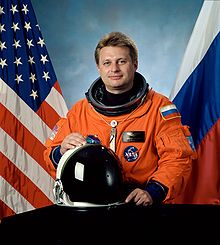Yury Onufriyenko
Russian - (RFSA)
Retired
Date of Birth: Feb. 6, 1961
Age: 64
Col. Yuri Ivanovich Onufriyenko (Russian: Юрий Иванович Онуфриенко, Ukrainian: Юрій Іванович Онуфрієнко) (born 6 February 1961) is a retired Russian cosmonaut. He is a veteran of two extended spaceflights, aboard the space station Mir in 1996 and aboard the International Space Station in 2001-2002.
Soyuz-U | Soyuz TM-23
Russian Federal Space Agency (ROSCOSMOS) | RussiaBaikonur Cosmodrome, Republic of Kazakhstan
Feb. 21, 1996, 12:34 p.m.
Status: Success
Mission:
Soyuz TM-23 was the 25th mission and the 21st long-duration expedition to Mir space station. It was also a part of the US/Russian Shuttle-Mir Program. The mission began on February 21, 1996, 12:34:05 UTC, launching Commander Yuri Onufrienko and Flight Engineer Yury Usachov into orbit. They docked with Mir two days later. During their stay there, cosmonauts performed several EVAs and various scientific experiments. Station crew was visited by several Progress resupply spacecrafts, STS-76, and welcomed aboard Soyuz TM-24 with the next expedition crew. The mission concluded with a safe landing back on Earth on September 2, 1996, 07:41:40 UTC.
Low Earth OrbitSpace Shuttle Endeavour / OV-105 | STS-108
National Aeronautics and Space Administration | United States of AmericaKennedy Space Center, FL, USA
Dec. 5, 2001, 10:19 p.m.
Status: Success
Mission:
STS-108 was a Space Shuttle mission to the International Space Station (ISS) flown by Space Shuttle Endeavour. Its primary objective was to deliver supplies to and help maintain the ISS. It was the 12th shuttle flight to visit the International Space Station and the first since the installation of the Russian airlock called Pirs on the station. Endeavour delivered the Expedition 4 crew to the orbital outpost. The Expedition 3 crew returned to Earth on Endeavour.
Low Earth OrbitSpace Shuttle Endeavour / OV-105 | STS-111
National Aeronautics and Space Administration | United States of AmericaKennedy Space Center, FL, USA
June 5, 2002, 9:22 p.m.
Status: Success
Mission:
STS-111 was a space shuttle mission to the International Space Station (ISS) flown by Space Shuttle Endeavour. STS-111 resupplied the station and replaced the Expedition 4 crew with the Expedition 5 crew. It was launched on 5 June 2002, from Kennedy Space Center, Florida.
Low Earth OrbitThe Roscosmos State Corporation for Space Activities, commonly known as Roscosmos, is the governmental body responsible for the space science program of the Russian Federation and general aerospace research. Soyuz has many launch locations the Russian sites are Baikonur, Plesetsk and Vostochny however Ariane also purchases the vehicle and launches it from French Guiana.
Long March 3B/E
Fengyun-4C
Launch Complex 2 (LC-2) - Xichang Satellite Launch Center, People's Republic of ChinaChina's geostationary meteorological satellite program FY-4 (Feng Yun 4) is the second generation of chinese geostationary meteorological satellites.
Long March 8A
SatNet LEO Group 17
Commercial LC-1 - Wenchang Space Launch Site, People's Republic of ChinaA batch of 9 Low Earth Orbit communication satellites for the Chinese state owned SatNet constellation operated by the China Satellite Network Group.…
Soyuz 2.1a
Obzor-R No.1
43/4 (43R) - Plesetsk Cosmodrome, Russian FederationNote: Assignment of payloads to this launch is uncertain. The Russian Obzor-R satellite is a planned X-band radar earth observation satellite desi…
LVM-3 (GSLV Mk III)
BlueBird Block 2 #1
Satish Dhawan Space Centre Second Launch Pad - Satish Dhawan Space Centre, IndiaAST SpaceMobile’s Block 2 BlueBird satellites are designed to deliver up to 10 times the bandwidth capacity of the BlueBird Block 1 satellites, requi…
Long March 12A
Demo Flight
Long March 12A Pad - Jiuquan Satellite Launch Center, People's Republic of ChinaFirst test launch of CASC/SAST’s Long March 12A rocket, with a dummy payload. The rocket’s 1st stage attempted to land on a landing pad about 300 km …




